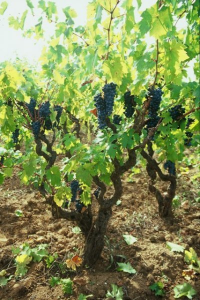
Puglia, the boot heel of Italy, hasn’t always had the best reputation for wine-making. For many years, it was known primarily as a source of bulk wines for blending or making vermouth. However, driven by economic forces, this situation is changing and now more than half of the region’s wine is produced under Italian wine quality laws.
The traditional training system used in Puglia is alberello, where vines are grown as low free-standing bushes rather than in neat lines strung out along wires. This style of growing is naturally low yielding and well-suited to the climate in Puglia, but also labor intensive as most of the work needs to be done by hand rather than using tractors. It’s a combination that makes profits difficult when wine prices are low and, in recent years, many bulk producers in the region have opted to accept EU payments to “grub up” their vines and leave the business. Those remaining are increasingly focused on putting wine into bottles instead of tank trucks.
Nearly three-fourths of the quality wine production in Puglia is based on just two grapes: Primitivo and Negroamaro (also written as Negro Amaro). Their dominant position likely comes from the one thing they have in common– an affinity for warm, dry weather.
Negroamaro is a dark, late ripening grape that has been cultivated in Puglia for at least 1,500 years and many people believe even longer, perhaps as long as 2,700 years. One possible origin for its name can be translated as “blackest of the black”, and wines made from it typically exhibit black fruit flavors with savory spice and herb notes. Historically, Negroamaro has been used as a blending grape to add body to other wines (often in other parts of Italy, or even other countries), but it can also make a structured, age-worthy wine by itself. A native Italian variety, nearly all of the world’s production of this grape is grown in Puglia.
Primitivo, on the other hand, is an early ripening red grape that was brought to Italy from Croatia only in the last few hundred years. Its name means something along the lines of “first one”, and it is typically harvested starting in August. (Primitivo is also one of the few grapes that can have a second harvest in the same year, typically 20 to 30 days after the first.) As discussed in Zinfandel’s Italian Cousin, Primitivo is a close relative of the much more famous Zinfandel, and it exhibits the same flavors in wine- red berries and jam with a touch of pepper.
A third grape worth noting is Malvasia Nera, an aromatic dark-skinned variety that is descended from Negroamaro and Malvasia Bianca Lunga. Like its lighter-skinned relatives, Malvasia Nera is known for enticing aromas and flavors when added into a wine blend. There are 11 classified reds based on a combination of Negroamaro and Malvasia Nera in Puglia, the most famous of which is Salice Salentino.
Examples of what to expect from wines made with these grapes are provided by three products I represent from Consorzio Produttori Vini of Manduria, Italy. Detailed descriptions are provided below.
Consorzio Produttori Vini Memoria Primitivo di Manduria 2013: This unoaked wine preserves the light, bright berry flavors and hint of sweetness that are the hallmarks of Primitivo/Zinfandel grapes. Earth and pepper aromas mingle with scents of blueberries. A medium dark ruby color promises a lot of flavor, and the Memoria delivers with just enough structuring tannins to give the wine focus. An easy-drinking, pleasant wine that is great for cookouts.
Consorzio Produttori Vini Neama Salento Negroamaro 2014: Dark ruby with purple highlights, this wine has savory aromas of black cherry and herbs with flavors of black cherry and black raspberry, a touch of clove, and moderate tannins. Well suited to grilled red meats and vegetables, it matches up nicely with onion and garlic flavors and can also work with savory spicy foods. For something out of the ordinary, try grilled tuna steaks with grilled peppers and grilled eggplant.
Consorzio Produttori Vini Salice Salentino Riserva 2011: This is a versatile wine that can pair with a range of foods from the sublime earthiness of truffles to the simple pleasures of a meat lovers pizza. It has a moderately dark ruby color with enticing aromas of raspberry and plum augmented by hints of allspice and vanilla that come from its time in French oak. Delicious flavors of cooked cherry and raspberry combine with nice structuring tannins and notes of nutmeg and allspice– a complex mingling with a long, pleasant finish. A local food match for Salice Salentino is Penne alla puttanesca (pasta with anchovies, onion, olives, tomato and capers). Foods with extended cooking times such as stews, roasts, and smoked meats are also good candidates to make the most of the layers of flavor in this wine.
